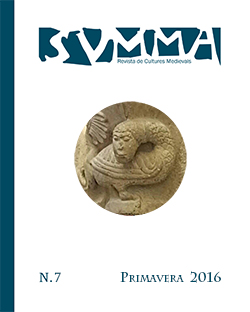Between Heavenly and Earthly Liturgy: The Paintings in the Chapel of the Abbey House of Moissac (end of the 12th Century)
DOI:
https://doi.org/10.1344/Svmma2016.7.2Paraules clau:
Moissac, abbot, Tree of Jesse, Christ Pantocrator, liturgy, sacred space, private space of devotionResum
A wall-painting programme of great quality dating from the late twelfth century is extant in the late eleventh-century lower chapel of the medieval tower located northeast of the apse of the abbey church of Moissac. It is possible that this area belonged to the hôtel Sainte-Foy, which fourteenth-century texts called the aula of the abbot. On the west wall of the chapel, a Tree of Jesse stretches across the barrel vault. The prophets, originally twelve, complete the central image. They are connected to the Apostolic College associated with the Christ Pantocrator placed next to depiction of Christ’s lineage.Besides the semantic richness of each image, their association in the space of the chapel is particularly significant. The polysemic programme evokes not only the continuity between the Old and New Testaments, but also, especially, the reaffirmation of the dual nature of Christ in the liturgical space and the meaning of the Church of Christ.
Upon their completion, the paintings of the chapel were the subject of particular attention: they were enriched with glass and metal cabochons, precious pigments, and gold, generating effects for the benefit of the viewers-actors who stood in this space.
We will look into both the meaning of these images and the staging of the sacred in a place of private devotion that was reserved for the abbot and the prestigious guests of the abbey.
Descàrregues
Publicades
Número
Secció
Llicència
Drets d'autor (c) 2016 Cécile Voyer

Aquesta obra està sota una llicència internacional Creative Commons Reconeixement-NoComercial-SenseObraDerivada 4.0.
Els autors que publiquen en aquesta revista estan d'acord amb els termes següents:
a. Els autors conserven els drets d'autoria i atorguen a la revista el dret de primera publicació de l'obra. SVMMA Revista de Cultures Medievals publica amb una llicència de Reconeixement-NoComercial-CompartirIgual 3.0 Espanya de Creative Commons, la qual permet compartir l'obra amb tercers, sempre que aquests en reconeguin l'autoria, sense ànim de lucre i compartin l'obra derivada en les mateixes condicions.
b. Els autors són lliures de fer acords contractuals addicionals independents per a la distribució no exclusiva de la versió de l'obra publicada a la revista (com ara la publicació en un repositori institucional o en un llibre), sempre que se'n reconegui la publicació inicial en aquesta revista.
c. S'encoratja els autors a publicar la seva obra en línia (en repositoris institucionals o a la seva pàgina web, per exemple), amb l'objectiu d'aconseguir intercanvis productius i fer que l'obra obtingui més citacions (vegeu The Effect of Open Access, en anglès).





